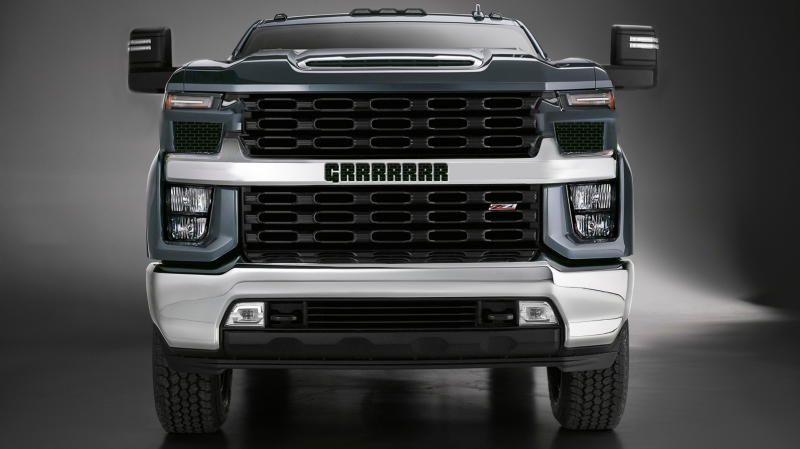
Whether you realize it or not, the fact is that at this very moment, in the year of Our Great Sky-Trucker 2018, there is something powerful and sinister happening in the world of truck grille design. Truck grilles are growing at alarming rates, and becoming more and more intricate, Baroque, and confrontational. The new 2020 Chevrolet Silverado HD is the worst offender yet, but it’s far from alone.
We’re in an alarming feedback loop of unhinged design, sales competition, and focus groups that’s threatening to suck us all through maws of vast meshes of perforated plastic and into the swirling blades of a radiator fan.
We need to talk about this.
Advertisement
First, though, I want to be clear that I do understand that trucks do need relatively big grilles. Large truck engines are tasked to do difficult things, not the least of which is the dreaded SAE J2807 test: a 100 degree Fahrenheit full-laden slog up the steep grade of the Colorado River’s Davis Dam while pulling a trailer and with the AC on full blast. To get through something like this without overheating, most trucks do need a good amount of airflow through the radiator, and the way to get that sweet sweet air in is with a good-sized grille.
Generously-sized grilles have always been part of truck design—well, at least front-engined, water-cooled truck design—but what we’re currently experiencing goes way beyond just having a big grille. The goal of modern truck grilles—especially the larger, Heavy Duty spec trucks—seems to be less about getting the required cooling air and more about creating a massive, brutal face of rage and intimidation.
Advertisement
We can trace this trend back to Dodge in the mid 1990s. Truck design had become a bit rote and boring, and Dodge was in the process of re-designing their Ram trucks. In an inspired move, Dodge designers took inspiration from big rig 18-wheeler trucks, creating a front end design that looked purposeful, powerful, and confident.
The front end was more sculptural, with a central bulging hood and lower fenders flanking it, capped with a large, bold grille front and center. It looked muscular and athletic and people loved it.
Advertisement
This sparked the current trend of front-end truck design that emphasizes size and strength primarily, though things have changed and evolved significantly since then.
The three-form front design of the Ram is not part of the other major truck makers design vocabulary generally, with major players like Ford and GM using a massive, monolithic one-block design for the front.
Advertisement
What they all have in common are colossal grilles that dominate the front ends of all their trucks, and have recently become more and more ornate and complicated and overdone masses of holes and thick slabs of chrome.
While the visual goal of big trucks has for years been to intimidate, I feel like now we’re veering into territory where the desired reaction from seeing a modern truck is short, involuntary emissions of urine right into your underpants.
Each of the Big Three American truck makers have their own takes on the same massive grille theme:
Ford likes giant belt-buckle-like expanses of chromed plastic, with fussy tight mesh-work and massive central bars that push the grille into the headlight’s territory, like a massive tumor taking over a face.
Advertisement
There’s a few variants of this concept, as seen on the F-250 and F-350:
Advertisement
The Raptor gets a snarly honeycomb grille with integrated little light jewelry and a big reminder of who built it:
Ram has sort of gone off the deep end as well, and while it has a number of different massive grille designs, it’s got a fondness for grilles that look like the snouts of giant cyborg warthogs, complete with flared nostrils:
Advertisement
Then, of course, we have GM, which just recently gave us this beast, the 2020 Silverado:
Advertisement
Most of these trucks are six feet tall or more, which means that the hood height is around four to five feet off the ground, which means that if one of these is behind you, you’re greeted with the sight of just grille, massive and hungry, filling your view.
Walking by trucks like these feels more like walking past a building sometimes, confronted with vast curtain walls of vents and meshes and perforated, vertical walls. They’re starting to feel less and less like vehicles.
It’s all starting to feel sort of insecure and crazy, if we’re honest. It’s not like any of these trucks actually looks all that good, really. It could just be me, but these massive, over-complicated grilles feel desperate and attention-hungry, like showing up at a barbecue slathered in blood and with your sleeve on fire so there will be no doubt as to what a badass you are.
Advertisement
I like pickup trucks. I like vehicles that have a job to do and are capable of doing it. I even owned a lifted pickup, once. But I’ve never felt the urge to drive something that looks like, were it to be given life by a mischievous, visiting wizard, would be shaking with constant rage and could only communicate via tortured, blood-curdling screams.
Pickup trucks are among the best-selling vehicles in America. I’m not exactly sure what the effect on our national mindset will be if we’re populating our roads with these colossal, wrathful gaping maws, but I don’t feel like it’s entirely healthy.
Advertisement
Well, at least our coolant will keep cool, even if we’re no longer capable.













